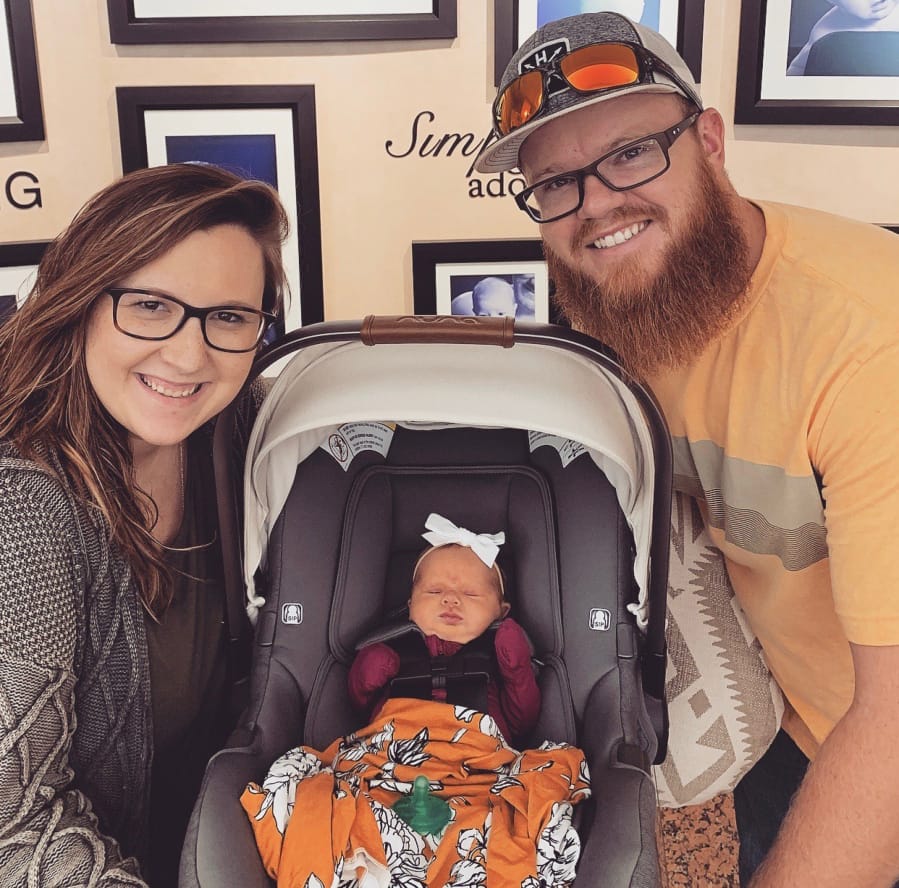In the weeks after having her first child, Kayla Edwards has been interviewed by USA Today, Time magazine, the “Today” show and “Tamron Hall,” a daytime talk show on ABC named after its host.
That most recent interview came last week on stage, with a live audience, while Hall asked the Vancouver native questions with her baby sitting soundly asleep in her arms. That display proves that Edwards’ daughter, 1-month-old Indy Pearl Edwards, is truly as “chill” as Edwards, 28, says she is.
But all the press proves that Indy is a historic, unique baby. Indy was born after her mother underwent a uterus transplant at Baylor University in Texas. There have only been four births at Baylor out of 20 mothers who have participated in uterus transplant trials. Only around 70 women in the world have undergone uterus transplants.
For Edwards, it’s been a hectic time ever since Indy was born at 8:45 a.m. Sept. 10 in the Dallas area, where Edwards and her husband, Lance, a 27-year-old Vancouver native, now live. She’s doing interviews to raise awareness about the transplant. Edwards was born with a genetic condition, Mayer-Rokitansky-Küster-Hauser syndrome, which affects around one in 4,500 women. She lacked a uterus, cervix and fallopian tubes, which meant that giving birth wasn’t possible.
In the future she wants the transplant available to more women.
“I’m pushing for it not to stop with us,” Edwards said over the phone from New York City. “I hope Baylor opens a program. I hope insurance starts funding these. I just hope it continues, because they did so much work and groundbreaking medical history that it just has to continue. Indy is such a joy to our lives that I just can’t imagine someone not experiencing that.”
Dr. Liza Johannesson, a principal investigator for the Baylor trials and a member of Edwards’ surgical team, said in a phone interview the uterus donor is first taken to surgery, where the uterus and connecting vessels are removed. The uterus is then put on ice, and blood is flushed out. Then the recipient is taken to surgery and the uterus is placed in the spot it ordinarily would be in, and then the donor’s vessels are connected to the recipient’s vessels.
“The uterus, in the end, sits in the place where it would have been from the beginning,” Johannesson said.
There’s an initial healing process, and then after a couple of weeks, Edwards began to have periods for the first time in her life. Then the medical team performed embryo transplants to get Edwards pregnant. It took doctors four times to transplant an embryo that led to Edwards’ pregnancy.
Johannesson was part of the medical team that did the first human uterus transplants in Sweden around 2012. She said the surgery has changed significantly since then. They used to only be able to have living donors. Now they can do living and deceased, Johannesson said.
The donor surgery has also become much less invasive. The last five donor cases have had robotic surgery, which only required five small incisions, and the uterus was pulled out through the vagina. It’s like laparoscopic, or keyhole, surgery. That means easier recovery for the donors, and less risk of complications.
Johannesson explained that donors must be healthy and have had a baby before, so doctors know the uterus works, and donors also must be premenopausal. Johannesson said that just in the U.S. there are hundreds of thousands to millions of women who could be recipients of a transplant like this.
“It has the potential to be among the most common transplantations we’re doing,” Johannesson said.
If the transplants become mainstream, there will need to be discussions about whether insurance pays for a procedure like this; there is no cost to the recipient or donor in the trial. Right now, there are seven ongoing uterus transplant pregnancies at Baylor (one baby is supposed to be born soon). Johannesson said the medical team plans to follow Indy, and the other babies, for at least 10 years.
“They’re part of our family,” Johannesson said. “We work so closely with these patients, and we see their struggles, from them coming to us and telling us about their infertility, and then to their changed life. We never want to let them go.”
Edwards has maternity leave through November, then she returns to her police and fire dispatch job in the Dallas area. With no interviews or TV appearances scheduled as of now, she’s looking forward to being a mom.
“I just want to lay at home with the baby, and not do anything,” Edwards said.




